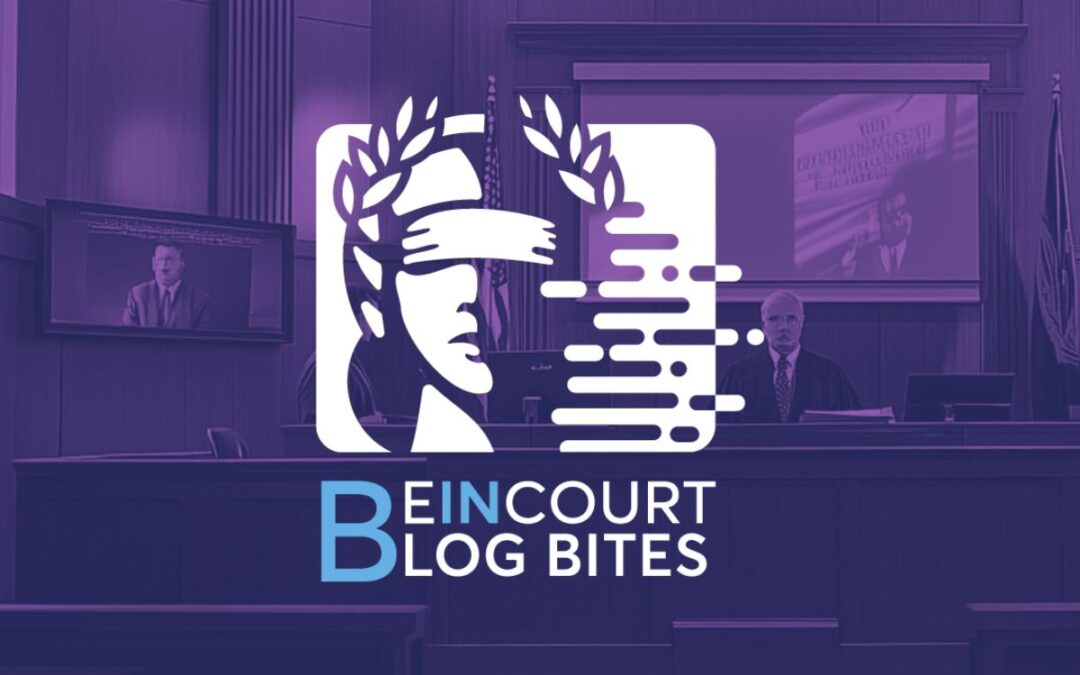As we kick off 2025 with BEINCOURT Blog Bites, we want to provide a practical guide for courts adopting hybrid courtroom technology. Hybrid proceedings and remote participation are rapidly becoming standard in modern courtrooms, and ensuring your technology supports these advancements is critical.
Here are the top 10 considerations to help courts evaluate their current systems, identify areas for improvement, and plan for a future-ready courtroom that supports accessibility, efficiency, and justice delivery.
1. Have You Evaluated the Readiness of Your Current Courtroom Audio and Video Technology?
- Are your audio and video systems capable of supporting clear communication for both in-person and remote participants?
- Do recurring issues like poor audio clarity, limited camera coverage, or inadequate displays disrupt hybrid proceedings?
- Is your existing infrastructure—wiring, power supply, and network capacity—sufficient to handle advanced AV systems and hybrid conferencing platforms?
- Are your courtroom’s current tools compatible with virtual meeting platforms like Zoom or Microsoft Teams?
2. Have You Established a Proper Technology Upgrade Budget?
- Have you assessed your current systems to identify the financial scope of necessary upgrades?
- Are funds allocated for core components like audio, video, and network infrastructure, as well as training and maintenance?
- Does your budget include contingency funds for unexpected issues or future scalability needs?
- Have you explored financing options or grant opportunities for courtroom technology improvements?
3. Are You Equipped for Hybrid and Remote Proceedings?
- Do your current systems allow seamless participation for remote judges, attorneys, witnesses, jurors, or interpreters?
- Can the system effectively support interpretation functionality for remote or in-person participants?
- Does it support consecutive, simultaneous, and simultaneous back-to-the-court interpretation functionality?
- Are high-definition cameras and microphones ensuring clear communication for all participants, both in-person and remote?
4. Are Your Court Recording Systems Adequate for Hybrid Proceedings?
- Does your current system record high-quality audio and video for both in-person and virtual participants, including interpreters?
- Would features like time-stamped recordings or integrated transcription tools streamline case review?
- Is your storage solution secure and accessible for managing hybrid courtroom recordings?
5. Are You Prioritizing Audio Clarity for Hybrid Needs?
- Are your microphones and speakers capable of delivering clear sound for remote participants and in-courtroom attendees, including interpreters?
- Are acoustic challenges, such as echo or noise interference, making it difficult for remote participants to follow proceedings?
- Do you have assistive listening systems that ensure all parties, including those joining remotely, can hear and participate effectively?
6. Is It Time to Upgrade Evidence Presentation Tools?
- Can your evidence presentation system share documents, videos, and exhibits seamlessly with remote participants, including interpreters who may need visual context?
- Would high-resolution displays and interactive tools improve how evidence is presented in hybrid or remote settings?
- Are secure, reliable connections in place for presenting digital evidence from both in-court and remote devices?
7. Are You Designing for Scalability and Flexibility?
- Is your system designed with hybrid growth in mind, including extra capacity for cameras, microphones, and conferencing platforms?
- Are modular components included to allow future upgrades or expansions for hybrid and remote technology?
- Have you anticipated future needs like AI-driven transcription, real-time translation for interpreters, or multi-room hybrid integrations?
8. Do You Need to Consider the Unique Challenges of a Historical Courthouse?
- Are non-invasive solutions, like mobile AV systems or concealed wiring, appropriate for hybrid technology integration?
- Have you planned for preserving the architectural integrity of your courthouse while enabling hybrid functionality?
- Do infrastructure limitations require custom designs for implementing hybrid or remote technology?
9. Have You Planned for Installation, Maintenance, and Support?
- Are your court staff prepared to manage the installation and integration of hybrid AV systems, or will you require outside integration support for this initiative?
- Does your chosen solution require advanced customization, programming, or specialized training for operation?
- Will your staff manage day-to-day maintenance, or will you require a long-term support contract with an outside provider?
- Are processes in place for routine software updates, hardware repairs, and system checks?
10. Do You Have a Disaster Recovery Plan for Hybrid Operations
- Can mobile systems be deployed quickly to maintain hybrid operations during emergencies or relocations?
- Are backup power systems and redundant internet connections in place to support remote proceedings without interruptions?
- Are your disaster recovery plans regularly tested to ensure hybrid capabilities remain operational?
How BEINCOURT Can Help
At BEINCOURT, we specialize in designing and delivering tailored courtroom technology solutions to meet the needs of modern courts. Our Complete Courtroom Solutions and EASYCOURT systems are built to handle hybrid proceedings of any size, from large, complex courtrooms to more cost-effective solutions for smaller or rural courts.
We understand the complexities of courtroom technology and provide end-to-end support, from initial assessment and design to installation, training, and ongoing maintenance. Whether you’re upgrading existing systems, addressing unique challenges, or building new capabilities, BEINCOURT is here to help.
We look forward to the opportunity to serve your court and help you achieve your technology goals in 2025. Feel free to contact us today to discuss your needs and explore how BEINCOURT can support your courtroom modernization efforts.
Final Thoughts
This guide highlights the top 10 considerations for courts adopting hybrid courtroom AV technology. Whether upgrading existing systems or building new capabilities, these questions will help courtroom technologists and decision-makers design solutions that enhance justice delivery and accessibility for all participants.
Let us know what topics you’d like us to cover in future BEINCOURT Blog Bites, and here’s to a successful 2025 for your court!

